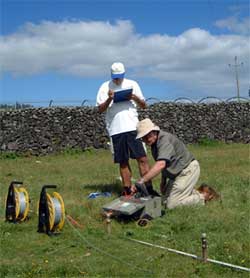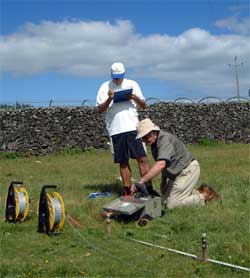 KINGSTON, R.I. — November 10, 2006 – The 58,000 residents of the Portuguese island of Terceira in the Azores, about 930 miles off the coast of Portugal, have a growing need for fresh water but a limited availability. Thanks to University of Rhode Island professors Daniel Urish and Reinhard Frohlich, potential new water resource locations have been found.
KINGSTON, R.I. — November 10, 2006 – The 58,000 residents of the Portuguese island of Terceira in the Azores, about 930 miles off the coast of Portugal, have a growing need for fresh water but a limited availability. Thanks to University of Rhode Island professors Daniel Urish and Reinhard Frohlich, potential new water resource locations have been found.
A summary of their research was presented at a meeting of the Society of Exploration Geophysics in Vancouver in August.
Groundwater is the sole source of fresh water for the island. While it receives abundant rainfall, there are few streams on the island because the water sinks rapidly into the highly permeable ground surface.
“Locating usable water supplies is a complex problem, especially because Terceira is an active volcanic island,” Urish said. “The groundwater is limited in supply and subject to pollution from highly mineralized geothermal waters, as well as from human-caused effects.”
Some water is obtained through underground “lava tubes” connected to volcanoes at the island’s highest point, but a limited recharge area and seasonal variability of precipitation make the source highly variable.
Over half of the island is used for agriculture, especially the raising of cows to produce cheese, the island’s most celebrated product. But cow wastes and chemical fertilizers contribute to the degradation of groundwater. “Cows produce nitrates, and when that gets into the water it can cause the fatal blue baby disease in infants who drink it,” Frohlich explained. “We had to look for water in places where the cows aren’t found, especially upslope from the farms.”
Using advanced geophysical survey and interpretive techniques in conjunction with existing well and test hole information, areas of the island were identified with the highest potential for fresh water resource development. Analysis of geo-electrical soundings made by the researchers produced four locations for potential potable groundwater development.
“One location is an old volcanic caldera that has a lot of soft material ejected from the volcano, and it’s there that we believe they can develop additional water supplies,” Frohlich said. “Another two areas are coastal where freshwater floats on the underlying salt water.”
The URI scientists said that the next step in confirming the availability of water will be conducted by scientists at the University of the Azores, who recently acquired high-tech geophysical measuring equipment that will allow them to expand the exploration done by Frohlich and Urish.
The URI research, including the training of Azorean students at URI and in the Azores, was funded by a three-year grant from the Portuguese-American Foundation, with additional support from the University of Azores and URI.
Pictured above
Dr. Reinhard Frohlich and University of the Azores student Luis Teixeira engaged in Geophysical work on the island of Terceira.

